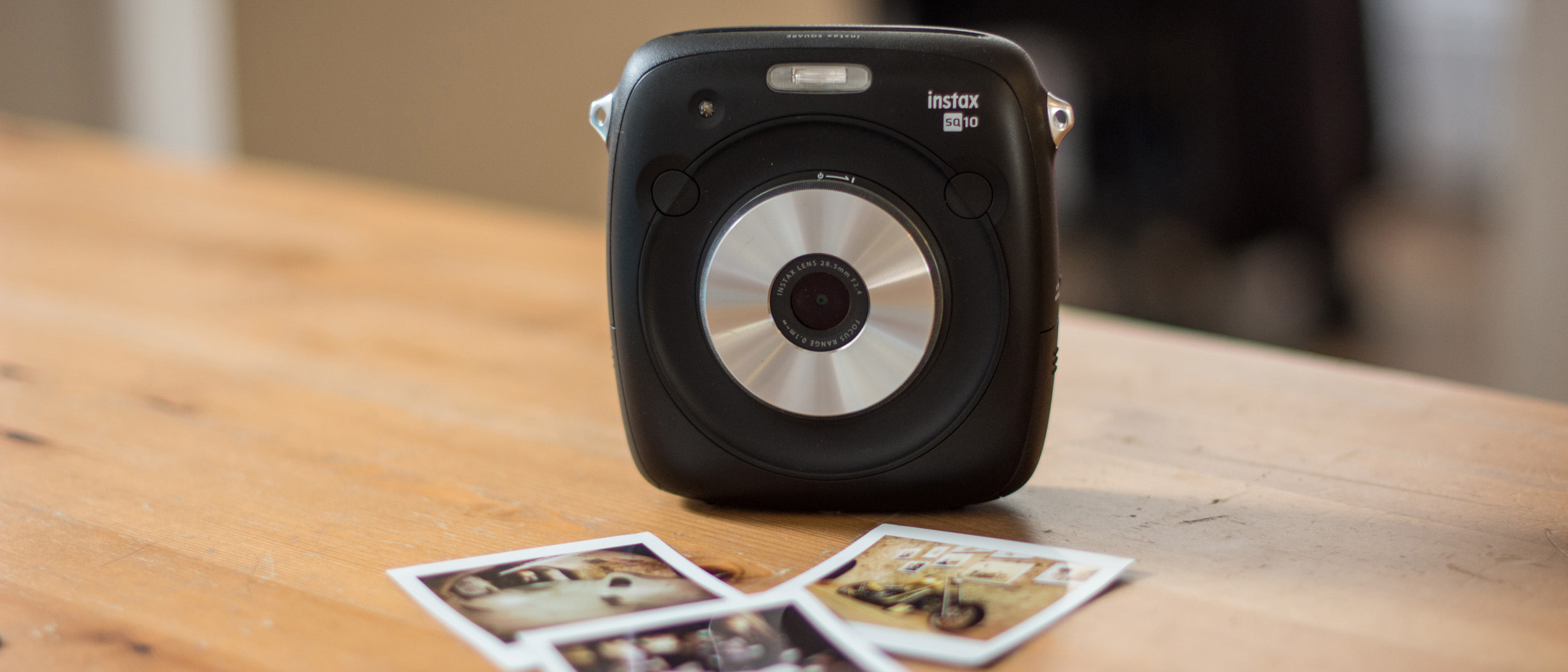TechRadar Verdict
The Fujifilm Instax Square SQ10 is a fun piece of kit, and if you'd like more control over images and the ability to adjust and edit in-camera, it's a good fit. But if you simply want fun, instant prints, the firm's cheaper Instax Wide, Mini and super-cool Mini 90 Neo Classic do just as good a job.
Pros
- +
Easy and fun to use
- +
Multiple instant prints
Cons
- -
Expensive
- -
Poor digital images
- -
Limited ISO range
Why you can trust TechRadar
The Instagram kids of today might think they invented the hyper-stylised, 1:1 square image, although of course their parents were happily printing and sharing such snaps with Polaroid cameras many moons ago.
But such is the popularity of image-heavy social media platforms that big-name camera manufacturers are revisiting the point, shoot and print market with innovative products that create tangible memories, and which endure for longer than it takes to get a couple of 'likes'.

Fujifilm's latest Instax Square SQ10 camera sits somewhere between its Mini and Wide range, using new-fangled square-format film and boasting digital camera functionality that the Japanese manufacturer hopes will appeal to a younger, more tech-savvy audience.
It's not a particularly good digital camera, however, and with most smartphones out-punching the Square SQ10's relatively puny 3.7MP 1/4-inch CMOS sensor, some will find it difficult to justify the asking price.
However, there are plenty of reasons to fall in love with this happy snapper.
Features
- 1/4-inch sensor, 3.7MP
- Fixed 28mm f/2.4 lens
- 3.0-inch screen, 460,000 dots
The most notable feature of the Fujifilm Instax Square SQ10 (aside from the new square-format film pack) is the ability to review and edit your shots via a small LCD display on the rear of the camera.
Previously, Instax owners would have to point, shoot and hope that the lighting was just right and the subject framed accordingly, as as you were stuck with what came out of the camera.
Sign up for breaking news, reviews, opinion, top tech deals, and more.

Now, users can shoot and store around 50 images to the camera's internal memory (and add a microSD card for further storage), then scroll through their shots to adjust brightness, add a vignette and play around with the 10 built-in filters that come pre-loaded.
When the user is completely happy with the image, they can then print as many copies as they want with the simple press of a button. It means you don't have to worry about wasting the relatively expensive film stock on duff pictures, while there also won't be any squabbles over who keeps the resulting hard copy.
Understandably, camera features are pretty limited, and seeing as this is designed with the casual user in mind that's probably a good thing.
The fixed aperture of f/2.4 and single autofocus system make it extremely easy to line up a shot, while the rear display makes it easy to ensure that everyone's in the frame and in focus. If the AF system is struggling, which it will do in low light situations, the AF box on the rear display will turn red to warn the user.

The auto shutter speed of 1/29500 sec to 1/2 sec doesn't allow for much creativity, while the auto ISO of 100 to 1600 may irk those who like to take full control over such settings.
However, users do have control over the built-in flash, with the option of auto modes, forced flash, suppressed flash, slow synchro and red eye removal, while three shooting modes (standard, bulb mode and double exposure) allow for some artistic freedom.
It's highly likely that most users will stick to the auto modes and play around with the vignette, brightness adjustment and built-in filter features, which can be applied to any photo after it's been captured.
Build and handling
- Robust plastic casing
- Weighs 450g
- Dimensions 119 x 47 x 127mm (WxDxH)
Operating the Fujifilm Instax Square SQ10 is unlike operating any other camera out there, as its square frame requires the user to grip its flanks, elbows extended outward for stability, and snap away using the two front shutter buttons.
It feels a bit like operating an underwater camera rig – albeit a much smaller version – but it doesn't take long to get used to.
The toy-like exterior is fashioned from some tough plastics, while a neat metallic ring around the lens takes care of power on and off. Film packs are loaded into the rear of the camera, and snaps are printed out of the top of the unit.
There are eyelets for attaching the provided hand strap – which we'd advise doing, as the camera doesn't have any patterning to aid grip, and can feel rather slippery at times.

At the rear sits the aforementioned LCD monitor, while a small jog wheel beneath this takes care of the camera's functionality, with the surrounding buttons allowing quick access to playback, vignette settings, filters and printing.
The overall design is all squares and circles and works well, but it doesn't feel particularly stable when perched on its base, and it's easy to accidentally lay it on its back or front, which could damage the lens or monitor.
Users can set up the two front buttons as they wish, so that both can operate as shutters or one can change the shooting mode, for example.
Once set up, taking a picture is as simple as pointing the camera at the subject and using the rear monitor the make sure things are lined up and exposed correctly. This is the first benefit of the instant/hybrid nature, although it can also prove fiddly.
By the time you've adjusted the brightness, chosen the correct flash mode and selected a filter, there's a danger the moment will have been lost, or your subject wandered off.
There's something beautifully simple about the more basic Instax models, which generate excitement and anticipation among friends as the film develops.
Have all the heads been cut off? Is someone pulling a silly face? Those questions are answered instantly here, as the shot appears on the rear monitor straight away, which can often lead to subjects asking for it to be deleted or amended before it has a chance to be forever committed to film.

Leon has been navigating a world where automotive and tech collide for almost 20 years, reporting on everything from in-car entertainment to robotised manufacturing plants. Currently, EVs are the focus of his attentions, but give it a few years and it will be electric vertical take-off and landing craft. Outside of work hours, he can be found tinkering with distinctly analogue motorcycles, because electric motors are no replacement for an old Honda inline four.
